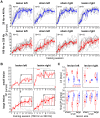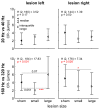Unilateral auditory cortex lesions impair or improve discrimination learning of amplitude modulated sounds, depending on lesion side
- PMID: 24466338
- PMCID: PMC3900711
- DOI: 10.1371/journal.pone.0087159
Unilateral auditory cortex lesions impair or improve discrimination learning of amplitude modulated sounds, depending on lesion side
Abstract
A fundamental principle of brain organization is bilateral symmetry of structures and functions. For spatial sensory and motor information processing, this organization is generally plausible subserving orientation and coordination of a bilaterally symmetric body. However, breaking of the symmetry principle is often seen for functions that depend on convergent information processing and lateralized output control, e.g. left hemispheric dominance for the linguistic speech system. Conversely, a subtle splitting of functions into hemispheres may occur if peripheral information from symmetric sense organs is partly redundant, e.g. auditory pattern recognition, and therefore allows central conceptualizations of complex stimuli from different feature viewpoints, as demonstrated e.g. for hemispheric analysis of frequency modulations in auditory cortex (AC) of mammals including humans. Here we demonstrate that discrimination learning of rapidly but not of slowly amplitude modulated tones is non-uniformly distributed across both hemispheres: While unilateral ablation of left AC in gerbils leads to impairment of normal discrimination learning of rapid amplitude modulations, right side ablations lead to improvement over normal learning. These results point to a rivalry interaction between both ACs in the intact brain where the right side competes with and weakens learning capability maximally attainable by the dominant left side alone.
Conflict of interest statement
Figures





References
-
- Budinger E, Heil P, Hess A, Scheich H (2006) Multisensory processing via early cortical stages: Connections of the primary auditory cortical field with other sensory systems. Neuroscience 143: 1065–1083. - PubMed
-
- Budinger E, Scheich H (2009) Anatomical connections suitable for the direct processing of neuronal information of different modalities via the rodent primary auditory cortex. Hear Res 258: 16–27. - PubMed
-
- Brechmann A, Gaschler-Markefski B, Sohr M, Yoneda K, Kaulisch T, et al. (2007) Working memory specific activity in auditory cortex: potential correlates of sequential processing and maintenance. Cereb Cortex 17: 2544–2552. - PubMed
-
- Ohl FW, Scheich H (2005) Learning-induced plasticity in animal and human auditory cortex. Curr Opin Neurobiol 15: 470–477. - PubMed
-
- Scheich H, Brechmann A, Brosch M, Budinger E, Ohl FW (2007) The cognitive auditory cortex: task-specificity of stimulus representations. Hear Res 229: 213–224. - PubMed
Publication types
MeSH terms
LinkOut - more resources
Full Text Sources
Other Literature Sources

